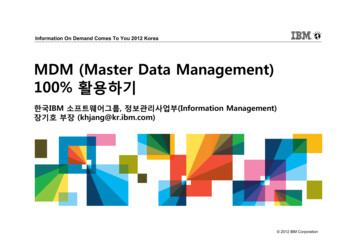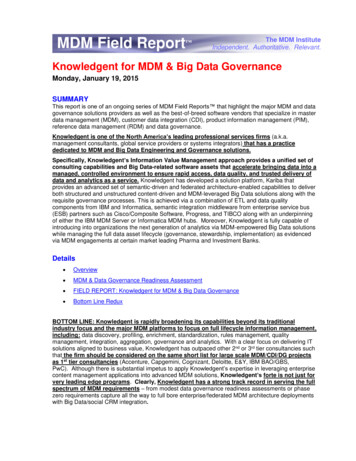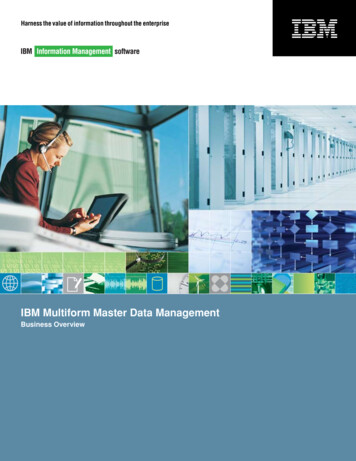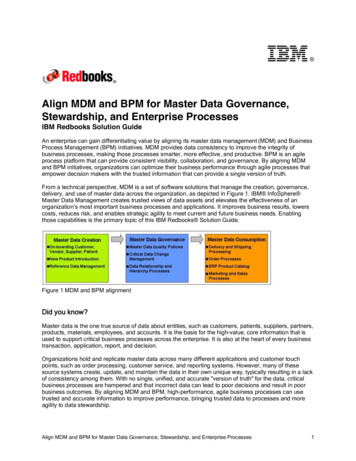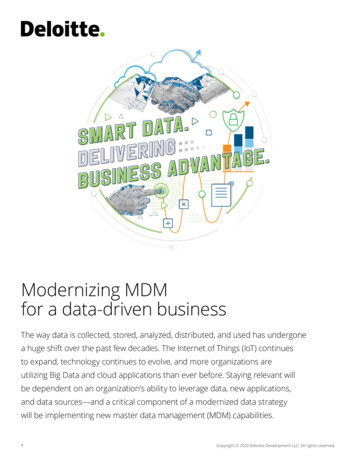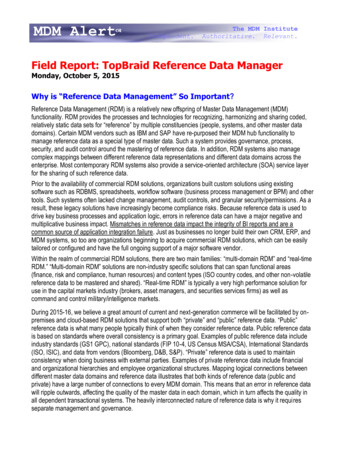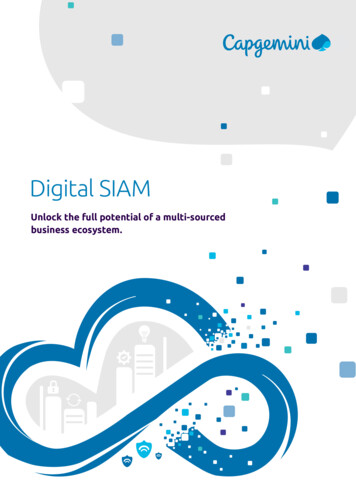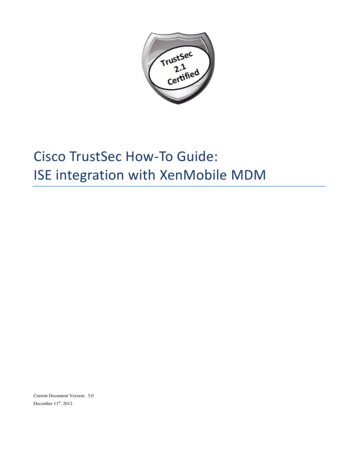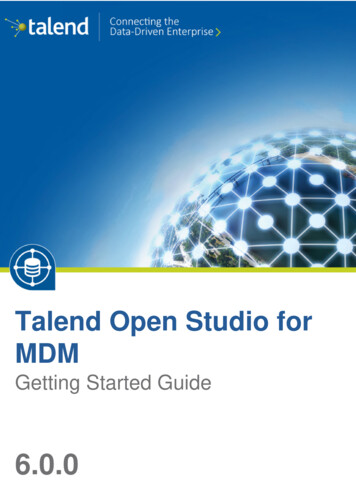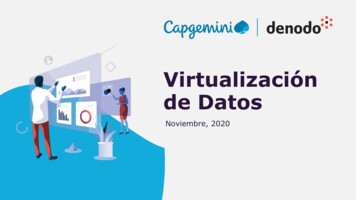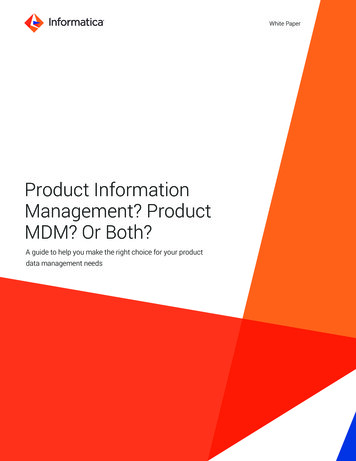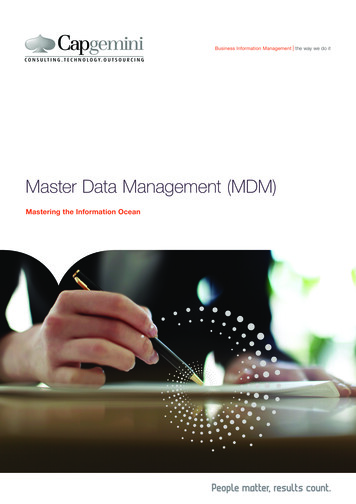
Transcription
Business Information Management the way we do itMaster Data Management (MDM)Mastering the Information Ocean
Mastery of information givesbusiness controlIn the modern business, the volume of information isincreasing and the value of that information is becoming evermore critical to the business’s success. The reality thoughis that over 80% of companies are relying on inaccuratemanagement reports and that most organizations findthemselves drowning in data. Although there are a largenumber of different challenges in turning data into information,there is one common element which drives problems in onethird of customer service interactions, 30% of brokeragetransactions and which drives up to 50bn in costs within theUS Retail supply chain alone – poor Master Data Management(MDM).MDM isn’t about fixing all of the data in an enterprise, it isabout turning the key entities into information and providingthe business with the control it needs to master all of the datathat it has. In a world where businesses are drowning in datait is MDM which provides the key points of stability and islandsof high quality managed information that enable a businessto take control and start navigating successfully through theinformation ocean.Implementing is a technology decision,approach is a business oneMDM is not a technology. There are technologies that can helpbut at its core it is about taking ownership and governanceof information within an organization. Whether the decisionis to implement these practises within current systems orto use a unifying MDM technology solution is secondary tounderstanding what you are going to govern and why.The two directions of MDMEvery organization faces two problems when it looks at itscurrent data issues:1. How to clean up the existing mess2. How to put in place the processes to manage master datagoing forward.These lead to two clear, but related, directions for MDM.The first is the look-back challenge of cleaning up the datapollution that currently exists. This is about uplifting the qualityof data to ensure that the look-forward strategy is workingfrom a more stable base and to address the immediateconcerns of the business with regards to data policy.The second, and most important, is the forward lookingapproach which modifies business processes and userinput of information to ensure that the quality is increasedand organizational policies enforced. This approach looksto ensure that the data in the company never degradesagain to its current level and will, over time, lift the quality ofcurrent information.Theoretically only the look-forward strategy is really requiredas over time it will improve the quality of information. In reality,however, it is the combination of look-forward and look-backwhich delivers the best business benefit. It should be notedthat there is no such thing as an effective look-back-onlystrategy. Uplifting the information quality at a point in timewithout having the forward looking process, governance anduser input changes ensures that the exercise will have to berepeated over and over again without delivering an informationset that the business can consistently trust.When embarking on an MDM journey it is important toconsider both forwards and backwards views to ensure thelong term viability of information within the enterprise.The three seas of MDMWhen looking at managing information, most organizations,today, view information from a database or technicalperspective. They view their core master data typically inthree broad groups: “Parties”, “Products” and “Locations”. Butthis approach is unlikely to solve the problem as it does notdirectly address the business issue.The key with Master Data is to recognize that there are in factthree distinct areas, or “seas” of Master Data which is a way ofviewing MDM from a business perspective. The reality is thatMDM is a business challenge and different areas of businessrequire different approaches to MDM.The first stage of effective information management, therefore,is to understand which sea of data you are drowning in andtaking control of that business problem.2Master Data Management (MDM)
Business Information Management the way do see itThe business challenge of Customer Centric MDM, therefore,is to truly understand how as a business you want to manageyour customers and what rules and mechanisms you wantto put in place to ensure that you have the most accurateinformation available on which to make customer decisions.Without a clear Customer Centric MDM approach it isimpossible to understand the opportunities, history and riskassociated with a business’s customer base.Figure 1: The three seas of MDMCustomer Centric MDM drives millions of dollars a year inadditional opportunity. The more federated the business andthe more externally facing the customer parts of the business,the more value that MDM can deliver.Enterprise Centric MDMEnterprise CentricSupply CentricCustomer CentricCustomer Centric MDMCustomer Centric MDM is about value creation for anorganization. The focus here is on how to sell and servicemore effectively and how to obtain a truly global view of yourcustomers and your dealings with them. The business case forCustomer Centric MDM is therefore about improving the onethird of interactions with a customer that are handled badlydue to poor master information and reducing the marketingcosts by making them more precise. Customer CentricMDM is not simply about understanding the core customerinformation, it’s about understanding their relationships andthe types of products and interactions they have with thebusiness. Customer Centric MDM is about providing the fullview of the customer. This means not simply creating highquality customer information but also ensuring that the fullview of their purchases, products and interactions can beconstructed in an accurate manner.Customer Centric MDM is an outward facing businesssolution; it aims to create the most complete view ofcustomers and prospects. This often involves integratingwith external information sources, particularly businesspartners where sales are indirect. With the rise of social mediaand social marketing campaigns the external challenge ofCustomer Centric MDM is increasing. It is becoming importantto integrate your internal customer view with the externalsocial view of the customer – this helps coordinate socialand physical campaigns and provides early indications ofproblems as customers are very likely to complain via socialmedia to their friends.Enterprise Centric MDM is about taking control of yourbusiness internally and driving full enterprise consistency.This form of MDM tends to focus on the internal aspects ofa business, the general ledger, HR, cost codes and internalassets including contracts and buildings. This form of MDMrequires strong business governance in the standardizationof regulations and definitions. With a company whose majorasset is their people it’s important to have a real global viewof those people. Having one set of people being experts in“Assets” and others in ”Property” causes real difficulties if youcan’t recognize that they are in fact the same skills. Equally,proficiency in Oracle UCM (Universal Content Management)doesn’t equal proficiency in Oracle UCM (Universal CustomerMaster)!Enterprise Centric MDM is part of turning federatedbusinesses into unified concerns. It ensures that theorganization can collaborate across its internal boundariesand enables active decisions to be made at a corporate levelwhich are backed by a full view on the operating health ofthe company.Enterprise Centric MDM is an internally focused approachwhere the ambition is to control and standardize how thecompany manages its information and information processes.This requires the internal parts of an organization to make itsimple and effective to manage this information in order toprovide the islands of trusted information from which highquality decision can be made.Supply Centric MDMThe final “sea” for MDM is that of Supply Centric MDM. Thisis another externally focused MDM area which looks beyondthe organization and into its supply chain. The focus is onoptimizing and reducing costs. MDM here has an externalchallenge of mapping internal to external product catalogsto provide the business with the unified view of exactly whatproducts are being bought. The job of Supply Centric MDM isto ensure that the company has a single definition of productsindependently of suppliers and that it is clear which suppliersare part of larger organizations where bigger procurementcontracts could be signed.3
Supply Centric MDM requires rigor and control in how youonboard suppliers and products and strict control on how youcreate your internal catalogs to prevent duplications. Thereis normally a significant amount of forward looking MDMrequired to secure the long term savings in this area and alarge amount of work matching historical information into thenew standardized catalogue.Supply Centric MDM looks outwards from the organizationand creates a unified internal view of the external landscape.By providing this internal control of a major data federationproblem it becomes possible to simplify and rationalize internalprocesses and significantly reduce the organization’s supplycosts. This is almost more critical in nonphysical industriessuch as finance where the creation and expansion of producttypes can happen at an astonishing rate. Supply Centric MDMgives control and consistency while reducing risk and slashingcosts.Four types of master informationIn all business problems there are always three types ofinformation which need to be mastered:1.Parties – individuals or organizations, customers,suppliers, employees, etc2. Assets – “things” whether they be real (spades), virtual(contracts) or a combination of both (gold futures) 43. Locations – physical such as geographical or postal andelectronic such a phone numbers, email addresses ortwitter accounts.These are the core information types that need to be managedand it is these elements that require the matching and mergingrules as well as onboarding and lifecycle processes clearlydefined.The final type of information to be mastered is the relationshipsbetween these information types: the locations for anindividual, the corporate structure of a company and the partstructure of a major product.In order for MDM to be truly successful the organization mustlook to manage each of these within the various businessdomains rather than looking to manage the information typesas data objects across the enterprise. It is extremely limitingto consider only a single entity when mastering information;solutions which attempt to take a technical and entity-centricapproach can often initially appear to offer reduced costs butin reality they fail to deliver on their business objectives andend up costing significantly more as new entities are added.The customer view isn’t complete without the product view.4Master Data Management (MDM)Figure 2: Figure titlePartiesThingsRelationshipsLocationsThe supplier view is nothing without the unified catalog.Every MDM business area needs to consider all three of theinformation types and to be clear which, if not all, of them arerequired to be mastered.Taking a business-centric view of MDM makes it clear that adatabase or technical view of customer or product masteringis like wondering whether the rudder or the sails are requiredwhen steering a boat. The answer is that when looked at fromthe perspective of the boat you are going to need both ofthem.Location is slightly different in that most locations haveexternal bodies which dictate their values. The key questionwith locations, however, is whether channel shifting fromphysical to electronic approaches is important in that area. If itis then you must treat locations in the same way as parties – astandard type with subtypes. Having an MDM solution thathas different structural approaches for physical and electroniclocations is only going to hinder channel shifting.Relationships are the final piece. It is these that help build upthe full picture of the business, the relationship of the customerto their products and locations, the relationship of the supplierto its parent organization and the relationship of cost codesacross the group.With these four types of information it becomes possibleto create the trusted islands of information stability whichhelp the business to navigate the broader ocean. This iswhat makes MDM simple and powerful: the combinationof business clarity and simplified information models. Thechallenge is that to achieve simplicity a higher degree of rigormust be instituted than is in place with most businesses today.
Business Information Management the way do see itFive classifications of informationNot all information is created equally and a major problemwith many MDM implementations is treating all informationas if it requires the same amount of control, distribution andrigor. The reality is that there are five broad classifications ofinformation, two of which are relatively static between thethree ”seas” of MDM and the remainder are down to the localbusiness demands. These five are:1.Core – this is the information that is required for the uniqueidentification of the entitypossible to create a simple technical solution which deliversthe business benefits. Too often MDM solutions are hamperedbecause they become complex technical solutions whichattempt to address centrally a problem that is better solvedlocally.MDM can be made into a simple technical solution byconcentrating on the business solution required andaddressing only that information which is required to createthe master information, and delegating other information setsuntil later phases or into non-master (Share, Local) categories.This is the underlying principle of the Capgemini LEAN MDMapproach.Mastering the CoreFigure 3: Figure titleCore attributes are those which are required to uniquelyidentify an entity independently of their system identifier.These are the “natural” identifiers for an entity and it is theseelements which are used in matching and merging to createindividual unique identities which can then be mapped backinto their multiple organizational representations.CoreThe key to the core information is the recognition that itshould be the minimum amount of information required touniquely identify an entity, not every single attribute thatcould potentially be useful in identification. The Core thereforeis the area where quality has to be at its highest and theFigure 4: Figure title2. Sync – this is information which is common betweensystems and needs to be kept synchronized3. Share – this is information which is calculated offline butneeds to be shared operationally4. Local – this is information which can, and should, beshared directly from its source5. Technical – these are technical identifiers which enable thesystem cross-reference to be built.CoreSyncMDM is fundamentally only about Core, Sync and Technicaland these elements have different purposes and governancemodels.By concentrating MDM on these core areas and treating themeach with the required rigor and control and critically, and notpolluting the core MDM with additional information it becomes5
greatest investment made in both forwards and backwardslooking MDM to ensure that entities are correctly described.Some central policy needs to be agreed and then enforcedconsistently across the organization. Core information isalways considered to be synchronized.Keeping on the same pageThe second set of information is that which needs to beconsistent across multiple systems. This is information whichis edited and modified in multiple places and therefore needsto be synchronized. This information set, therefore, is onewhere multiple areas must agree on a common policy and onquestions such as information latency. The rigor required isnot as significant as in the Core but the impacts of disparatequality rules will rapidly become apparent.Critically in a pure MDM sense, synchronized informationshould, but does not have to, be mastered in a common setof policies. It is possible to have in place a synchronizationmechanism which does not enforce quality standards andrules. This is rarely desirable in the long term but it does meanthat an iterative approach can be taken when looking at MDMprograms. The key factor with synchronization is that it isdone where multiple parties and systems are editing the sameinformation, not simply where one party is editing and otherswant to read.Figure 5: Figure titleSyncCoreShare6Master Data Management (MDM)Technical keys are the business keyThe final part of MDM is one that is often relegated to aninternally focused piece of MDM and which is even frownedupon by some MDM technologists as being part of “just” aregistry model. This dismissing of a technical piece misses thereality of its power for the business. The keys are the primarynavigation routes between systems. It is these pieces ofcritical information that provide the assured mapping betweenthe core information set and the other information related tothat entity that exists within the enterprise.Although they are technical keys their real power is that theyprovide a clear map for the business, linked to the highlytrusted core information, which describes all of the places thatrelated information is stored. The technical keys, therefore, arenot simply a technical element but represent the ability to shiftdecision making away from the data warehouse and into themain operational stream.The power of modern MDM is that it provides the businesswith the information cross-reference which enables the fullglobal map to be created.Share is not SyncOne group of information that is often mistakenly includedwithin the Synchronization group is that which one partof the business creates and modifies while others wish toconsume. Risk ratings, marketing assessments and otheranalytic elements are included in this group. These are piecesof information where there is a clear business owner andwhere the quality of the information is the sole responsibilityof that business owner. The rest of the business then takesthat information and uses it within its own analytical andoperational processes.Share is not the same as Sync as it is a simple publication ofinformation from a single trusted source. Shared informationcan often be simply local information which for operationalreasons needs to be either sent to the various target systemsor stored within an operational data store. It is very importantto recognize in the Share model that the governance of theinformation remains with the creating business owner and thatthe information is not considered available for modification byconsumers.
Business Information Management the way do see itLocal is globalThe final set of information is where many organizations maketheir mistake. There are large swathes of information whichwould be better off being left in their source systems andexposed via service-based interfaces. The MDM technicalkeys mean that it is much more effective to leave theinformation within source systems and use Service-orientedArchitecture (SOA)-based approaches to make it availableoperationally rather than dumping the information into theMDM solution.The more information that can be left in its source systemsrather than moved into a “Share” the better, as it reduces theinformation latency and helps ensure that the governance onthe information remains as close as possible to its point ofcontrol. An approach that leaves information stored locallyis able to enforce security rules locally rather than having toenforce these differing policy rules within a centralized store,or more likely failing to enforce those rules successfully withina centralized store.The other big advantage of leaving information locally isinformation latency. Moving information into a “Share”inevitability means that it is not the current real-time viewof that information. For elements which are calculated afterhours this may not be a problem but for dynamic informationsuch as stock levels and credit balances it is much morecritical to have this information as accurate as possible. Withorganizations looking to drive more efficiency and accuracy intheir operations the objective should be to minimize “Share”and maximize “Local” as much as possible.One timeframe – real-timeThe final aspect of modern MDM is the switch from posttransactional to operational. The history of MDM has beenas a technical filter before the data warehouse. This provideddecent management information but didn’t provide an updateto the core operational processes. This split between posttransactional accuracy and operational inaccuracy meant thatit was possible to determine afterwards what would have beenthe right decision had the business had the right information.The advantage of modern technology infrastructures,particular those which are based around SOA principles,is that MDM can move out of the darkness of the posttransactional world and bring high quality assured informationinto operational processes.The power of the technical crossreference in MDM when alliedto local information stores is that it becomes possible for thesame information to be available operationally as is availablein the data warehouse with the same high quality, but withmuch lower information latency. MDM therefore helps to solveproblems not simply after the fact in information reporting andstrategy but within the core enterprise processes themselves.SummaryMDM is not a complex technical challenge when viewedfrom a business perspective. The three clear business “seas”of MDM: Customer Centric, Enterprise Centric and SupplyCentric have different business drivers and, critically, differentbusiness governance models. By focusing on the businessdomain it becomes possible to construct simplified technicalsolutions which address each of these domains and whichtake a more pragmatic and operationalcentric view than theMDM solutions which currently focus on the data warehouse.MDM, when viewed from a business perspective, spansmultiple technical areas but provides a business-centric,unified, highly trusted set of core information from whichthe full information map of a customer, supplier, product orenterprise can be created.MDM is not about providing that view, it is about enablingthat view and ensuring that the map is as accurate andcomplete as possible. When looking at the masses of data inan organization, it is these islands of highly trusted informationand the map that they provide which deliver the levers anddirections to enable business to take control in converting datato information. Mastering information across the enterprisestarts with understanding which information ocean you aredrowning in and then building these islands of stability. Fromthere it becomes possible to uplift the quality and trust moregenerally and to clearly identify how information is related asa business rather than simply as a series of technical datastores. By rigorously focusing on this challenge and creatingthe simplest possible solution that delivers the islands ofstability, it finally becomes possible to reliably and efficientlymaster the core information in the enterprise to enablenavigation across the enterprise information ocean.7
Business Information Management the way we do itAbout CapgeminiWith almost 140,000 people in over 40 countries, Capgemini is one ofthe world’s foremost providers of consulting, technology and outsourcingservices. The Group reported 2013 global revenues of EUR 10.1 billion.Together with its clients, Capgemini creates and delivers business andtechnology solutions that fit their needs and drive the results they want.A deeply multicultural organization, Capgemini has developed its ownway of working, the Collaborative Business ExperienceTM, and draws onRightshore , its worldwide delivery model.Learn more about us atwww.capgemini.com/bimbim@capgemini.comThe information contained in this document is proprietary. 2014 Capgemini. All rights reserved.Rightshore is a trademark belonging to Capgemini.MCOS GI AH 20141129or contact us at
three distinct areas, or "seas" of Master Data which is a way of viewing MDM from a business perspective. The reality is that MDM is a business challenge and different areas of business require different approaches to MDM. The first stage of effective information management, therefore, is to understand which sea of data you are drowning in and
